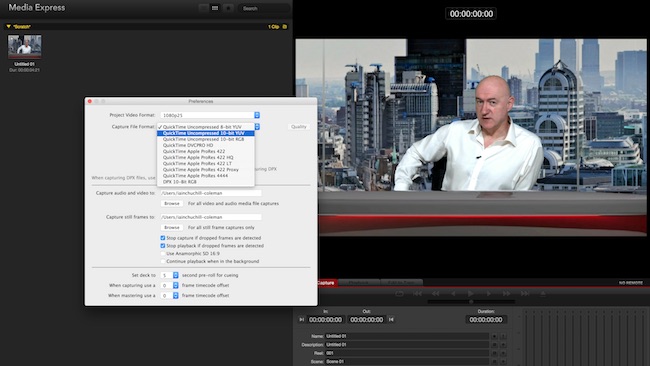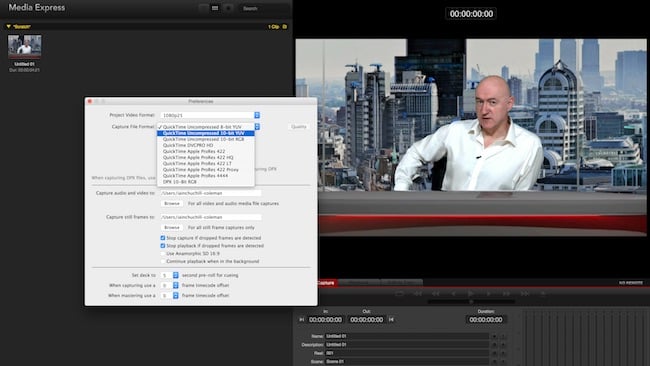

Blackmagic Designs’ Intensity Shuttle has been available for a few years now, but, with an open and extensible SDK, is a fine example of a product that has been made still relevant for modern video production. By Iain Churchill-Coleman.
Supported under Windows, Linux & OSX platforms (connecting via Thunderbolt or USB3), the Intensity is a stylish, small form SD/HD video i/o unit that sports a range of video connectivity options.
But what can you actually do with it?
On the HDMI input side of things, one of the most useful applications is to record the signal directly from your camera's HDMI output (read ‘image-sensor’) to a pristine, frame-based file format such as ProRes.
In bypassing the camera's image compression algorithms, designed to maximise record time on small memory cards, we also bypass visible (and indeed invisible) picture characteristics (artifacts) in your recordings inherent to the compression scheme. With up to 10-bit video sampling resolution supported by the Intensity, the resulting quality delivers sharper images, with improved colour depth, that are able to better withstand keying and colour-grade in the post-production stages. That type of application is going to work very well in the smaller, fixed production setup, but could also be usefully rolled out to field shoots as the unit takes its bus power direct from the host computer.
The HDMI input route is attractive too for console-based gamers that require a capture feed of their gameplay ‘straight out the box’ - for online distribution or file delivery.
But it’s not ‘all digital’. For those tasked with rescuing tape-based video footage for archive and restoration jobs, the wide range of analogue inputs on the unit will assist salvaging fading legacy media from almost certain demise!
Of course, all the same physical input connectivity is replicated on the output side, where Intensity will connect to a wealth of renowned editing, grading & compositing apps (see full list below) for monitoring or presentation purposes. If you don’t happen to own a 3rd party app for your connection to the Intensity, BlackMagic have been kind enough to bundle the excellent MediaExpress utility in the package - providing general capture, logging, asset management, playback and export functions.
MediaExpress is installed automatically with the unit’s driver setup routine. Once installed we found it easy and intuitive to use and after a few quick setup stages we were good to go. Onwards from MediaExpress, compliant mov/avi files can be output and sent straight to Blu-Ray authoring software for example. One thing to note: if you are working at 10-bit uncompressed you’ll need drives that are up to the job of dealing with the data rates involved!
We used Lightworks Pro v12.6 in our NLE test and after installation the device was ready for monitoring and capture work. Connected over Thunderbolt on our MacBook Pro, the scrub response from the timeline was snappy and the picture looked great on our HDMI display (even in 8-bit!). We also gave Premier CC and Avid MediaComposer a spin and the setup again was quick and easy with good results.
But there are other types of duties you can apply the Intensity to - of a slightly different nature than the standard ‘capture and replay’ scenario. The open and public availability of the BlackMagic SDK means that all sorts of image related softwares are making connection to Blackmagic’s i/o range via QuickTime & WDM/DirectShow. I’ve been working with VJ and projection mapping software of late (Resolume, Modul8 & MadMapper) and was pleased to see all those apps offering i/o connection to the Intensity. This connectivity makes integrating small (or large!)-form HDMI camera feeds into quality live productions effortless - but also will give you a direct output feed of your show - should you not wish to additionally burden the VJ software with recording your performance as well as playing it back!
The unit (and indeed the whole Blackmagic desktop i/o range) is also supported as an interface to streaming programs such as Flash MediaEncoder, Wirecast and LiveStream Procaster, giving users a neat way to connect all sorts of sources for their streaming delivery content.
So yes, the Intensity is still a relevant tool for today’s videographer and content creator. But it’s also now opened up to new users in different circles that need great a quality video i/o in their day-to-day activities.
Tags: Studio & Broadcast


Comments